Mendelian Genetics: Definition, Overview, Synonyms, Examples, Process, Factors, Topics
Mendelian genetics is the study of how traits are inherited from one generation to the next. It is based on the principles discovered by Gregor Mendel in the 19th century in his experiments with pea plants. Mendel observed patterns in how traits appeared over generations and gave the key laws of inheritance, the Law of Dominance, the Law of Segregation and the Law of Independent Assortment. These principles explain how dominant and recessive alleles determine traits in offspring.
This Story also Contains
- What are Mendelian Genetics?
- Mendelian Traits and Terminology
- Mendel’s Experiments
- Mendel's Laws of Inheritance
- Mendelian Crosses
- Applications of Mendelian Genetics
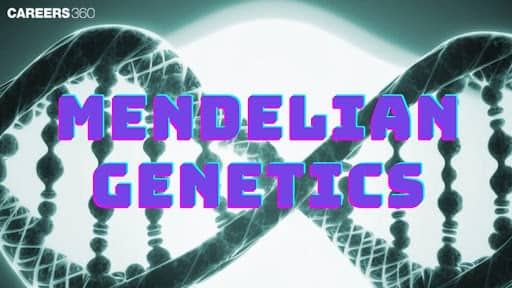
Mendelian genetics helps us understand how inherited traits work, predict genetic outcomes using Punnett squares and study human genetic disorders. In this article, we will understand Mendel’s experiments, different types of crosses, and applications of mendelian genetics.
What are Mendelian Genetics?
Mendelian genetics is the study of genes and their attributes as they are passed from one generation to another. It is named after Gregor Mendel. Mendelian genetics provides support for classical genetics and is very instrumental in helping to unlock how the mechanics of inheritance work. Mendelian inheritance explains how features are transmitted from one generation to another and how variation is brought into organisms and population.
Gregor Mendel, an Austrian monk, conducted experiments in the 19th century that contributed to the knowledge about heredity. Besides giving the fundamentals of heredity himself, he did the cross-breeding of pea plants and documented the pattern of inheritance of their different traits. His work later gained recognition and formed the base of modern genetics.
Mendelian Traits and Terminology
It is important to understand the basic genetic terms to understand the principles of inheritance proposed by Gregor Mendel. The following terms help to describe how traits are passed from one generation to the next through alleles and genes.
Term | Definition |
Gene | Unit of heredity that controls a particular trait |
Alternative form of gene | |
Genotype | The genetic constitution of an organism |
Phenotype | Observable expression of the genotype |
Homozygous | Possession of two copies of identical alleles of a trait |
Heterozygous | Possession of two different alleles of a trait |
Dominant | Allele masks the expression of the recessive |
Recessive | An allele whose expression is masked by a dominant allele |
Mendel’s Experiments
Gregor Mendel lived in an Augustinian monastery in Brno, where he conducted his famous experiments with pea plants. He was systematic and statistical in the analysis of trait inheritance, which was far ahead of his contemporaries.
Mendel worked with pea plants that expressed seven distinct traits: flower colour, seed shape, pod colour, pod shape, flower position, seed coat colour, and plant height. By cross-breeding plants and analysing progenies, he discovered that inheritance occurred in a very regular fashion. His careful breeding experiments and record-keeping led to the formulation of three basic laws of inheritance.
Mendel then cross-pollinated plants that had contrasting traits and traced the features in next generations. He established that plant traits do not blend but are passed down in discrete parcels. He referred to them as "factora," now called gene. This research explained the occurrence of dominant and recessive traits. His findings were published in 1866, but they were rediscovered and confirmed by other scientists.
Mendel's Laws of Inheritance
Mendel’s experiments using pea plants laid the foundation for understanding how traits are passed from parents to offspring. His observation led him to postulate the three Laws of Inheritance that explain genetic inheritance. These laws mark the beginning of genetics and are still relevant in modern biology.
Law of Segregation
Mendel's Law of Segregation states that during gamete formation, the two alleles of a trait separate, so each gamete passes only one allele for each trait. For example, if there is a plant having an allele for purple flowers (R) and an allele for white flowers (r) while making gametes, these will separate on their own, and some gametes will receive R and others r.
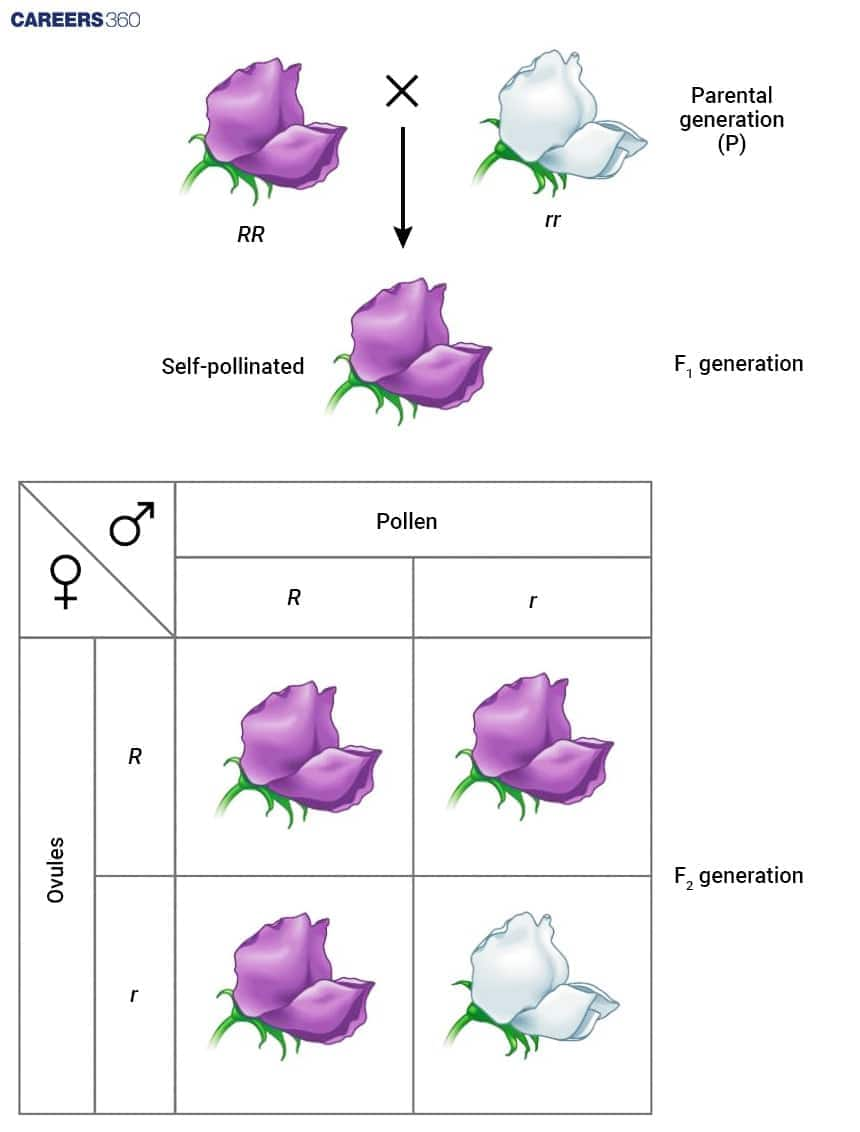
Law of Independent Assortment
Mendel's Law of Independent Assortment, states that the alleles for the different traits segregate independently of each other while forming gametes. This means that the inheritance of one trait will not interfere with the inheritance of another. For example, the allele of seed colour (yellow or green) is independent of that of seed shape (round or wrinkled).
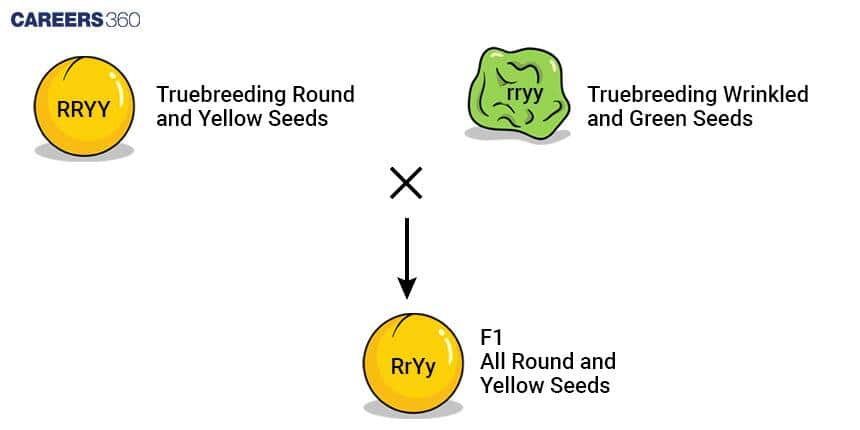
Law of Dominance
According to Mendel's Law of Dominance, if two alleles for a trait exist, then one allele will be expressed over the other allele. In his experiment, plants with the genotype Pp had purple flowers since the allele for purple flowers (P) was dominant over that for white flowers (p).
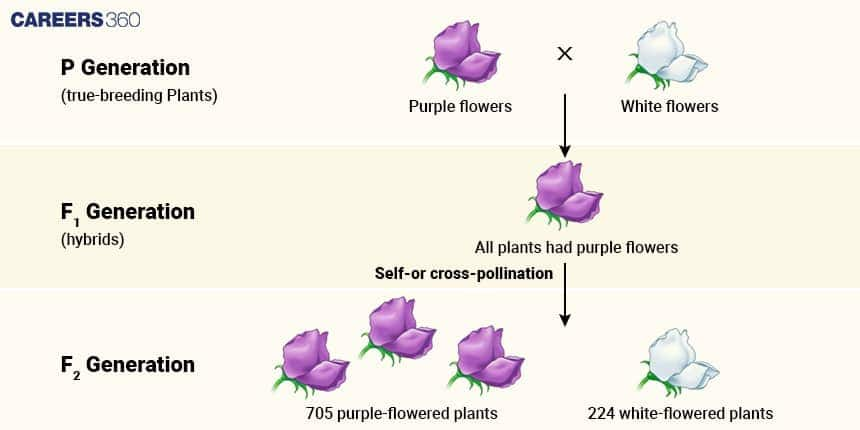
Mendelian Crosses
Mendelian crosses are breeding experiments used to study how traits are passed from one generation to the next. These crosses help to understand the basic pattern of inheritance. By crossing plants with different traits, Mendel was able to predict the genetic outcomes in offspring and develop his laws.
Monohybrid Cross
A Monohybrid cross deals with one trait. For example, crossing a homozygous dominant (PP) plant with one that is homozygous recessive (pp) will result in offspring that are all heterozygous (Pp), expressing the dominant phenotype.
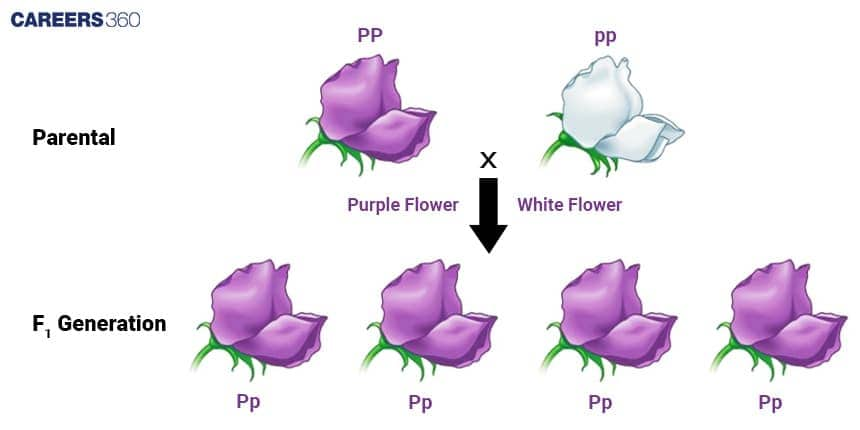
Dihybrid Cross
A dihybrid cross involves the crossing of two traits. For instance, plants can be crossed heterozygous for seed color (Yy) while, at the same time, heterozygous for seed shape (Rr). This will then give an offspring neither one nor even both traits. The ratio of phenotypes of offspring is usually 9:3:3:1.
Applications of Mendelian Genetics
Applications of Mendelian genetics can be broadly found in human genetics, plant breeding, and medical genetics. The geneticist can predict the occurrence of genetic disorders, the development of new crop varieties, and the improvement of livestock by selective breeding.
In human genetics, it helps in genetic counselling and diagnosing hereditary diseases owing to its Mendelian pattern of inheritance. Breeders apply Mendelian principles to genetically improve desired traits in plants and animals for greater productivity and sustainability in agriculture. Applications in these areas underscore the core role Mendelian genetics plays, both in basic research and in intervention strategies.
Recommended Video on Mendelian Genetics
MCQs on Mendelian Genetics
Q1. Alleles are:
different molecular forms of a gene
heterozygotes
different phenotype
true-breeding homozygotes
Correct Answer: 1) different molecular form of gene
Explanation:
Alleles are different gene variants or molecular forms that occur at the same location (locus) on a chromosome and are caused by mutations. Different characteristics or variances in an organism can be caused by alleles.
People who have two distinct alleles at a specific gene locus (such as Aa) are known as heterozygotes.
Various phenotypes Although alleles are not distinct phenotypes, phenotypes are the observable qualities or characteristics of an organism that arise from the expression of alleles.
Although this is not the definition of alleles, true-breeding homozygotes are organisms that have two identical alleles for a particular attribute (AA or aa, for example).
Hence, the correct answer is option 1) different molecular forms of a gene.
Q2. What is a phenotype?
The genetic makeup of an individual
The physical characteristics of an individual
The reproductive cells of an individual
The expression of a single gene
Correct Answer: 2) The physical characteristics of an individual
Explanation:
A phenotype is the observable physical and biochemical traits of an individual, such as height, hair color, and blood type. It is the result of the interaction between an individual's genetic makeup (genotype) and the environment. The phenotype can also include behavioral characteristics and susceptibility to certain diseases. The genotype refers to the genetic makeup of an individual, including all of the individual's genes and genetic variants. The reproductive cells of an individual are called gametes, and the expression of a single gene is just one part of the complex process that leads to the development of a phenotype.
Hence, the correct answer is option 2) The physical characteristics of an individual.
Also Read:
Frequently Asked Questions (FAQs)
The five types include autosomal dominant, autosomal recessive, X-linked dominant, X-linked recessive, and mitochondrial.
The three principles are the Law of Dominance, Law of Segregation, and Law of Independent Assortment.
It is a genetic model based on Mendel’s experiments, where traits are controlled by pairs of alleles passed from parent to offspring.
A monohybrid cross studies inheritance of one trait, while a dihybrid cross studies the inheritance of two traits simultaneously.
Homozygous means having two identical alleles for a gene, like AA (dominant) or aa (recessive)